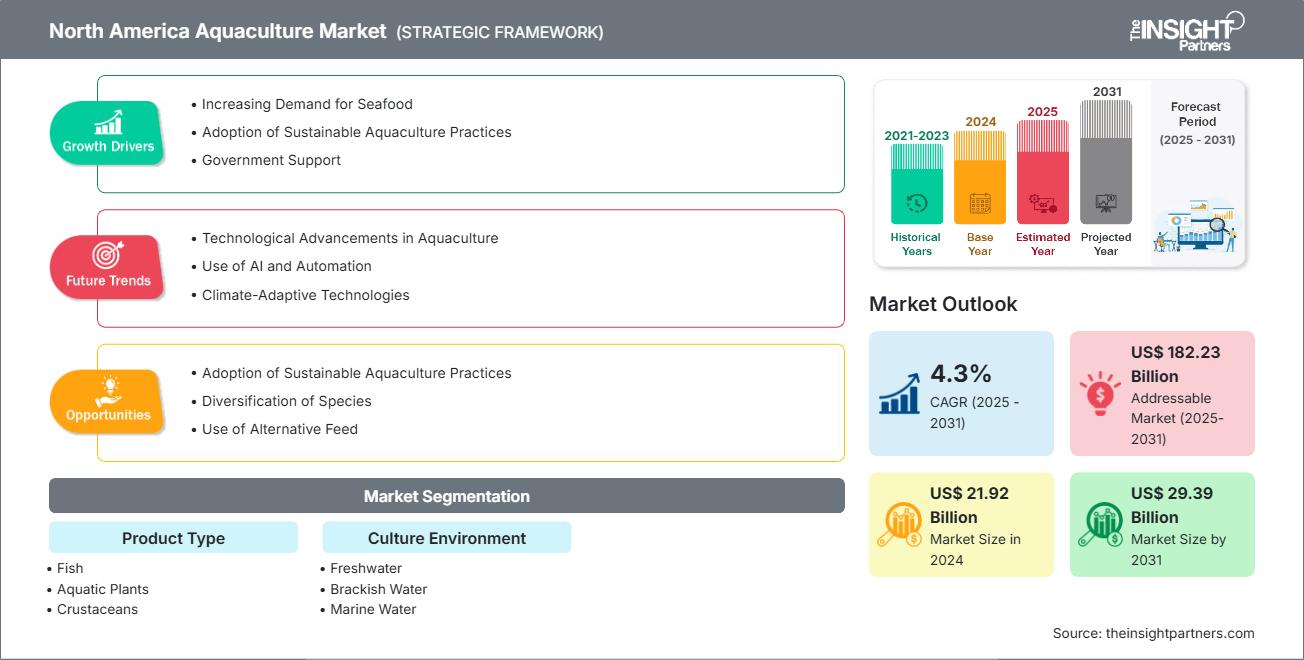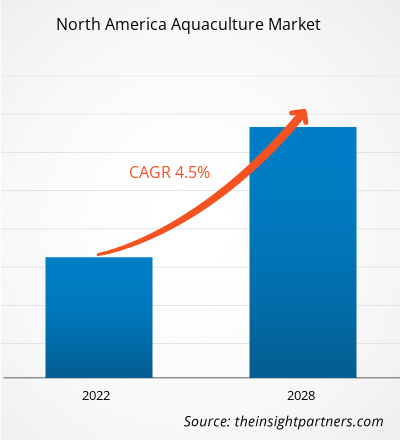北美水产养殖市场规模预计将从 2024 年的 219.2 亿美元增至 2031 年的 293.9 亿美元。预计 2025-2031 年期间该市场的复合年增长率 为4.3%。
北美水产养殖市场分析
北美水产养殖市场受海产品需求增长、可持续蛋白质来源以及养殖技术进步的驱动。日益增强的健康意识和野生鱼类资源的枯竭进一步推动了市场的增长。循环水养殖系统 ( RAS ) 的推广、精准水产养殖以及鲑鱼和贝类等高价值物种的养殖都蕴藏着巨大的机遇。政府的扶持政策、研发投入以及消费者对可追溯和环保产品的日益增长的偏好,为美国、加拿大和墨西哥的行业扩张带来了巨大的潜力。
北美水产养殖市场概览
北美国家,尤其是美国和加拿大,致力于提高国内海产品产量,以减少对进口的依赖,并满足日益增长的蛋白质需求。饲料、疾病控制和循环水养殖系统(RAS)方面的创新正在提高生产力和环境绩效。监管支持和消费者对本地养殖、可追溯和高品质海产品的需求进一步推动了该行业的发展。凭借充足的海岸线和科研投入,北美有望扩大其在水产养殖领域的作用。
您可以免费定制任何报告,包括本报告的部分内容、国家级分析、Excel 数据包,以及为初创企业和大学提供优惠和折扣
北美水产养殖市场:战略洞察

- 获取此报告的顶级关键市场趋势。此免费样品将包括数据分析,从市场趋势到估计和预测。
北美水产养殖市场驱动因素和机遇
市场驱动因素:
海鲜需求不断增长
人口的增长和饮食偏好的改变增加了对海鲜的需求。
野生鱼类资源减少
过度捕捞减少了野生捕捞量,增加了对养殖海鲜的需求。
技术进步
自动喂料和水质监测等创新提高了生产力。
健康意识
消费者寻求富含 Omega-3 脂肪酸的营养来源,尤其青睐水产养殖产品。
政府支持政策
法规和补贴鼓励水产养殖业的可持续发展。
研发投资
研究改善了疾病控制和饲料效率,提高了产量。
可追溯性需求
消费者更喜欢透明的供应链,以确保产品的安全和质量。
市场机会:
循环水养殖系统(RAS)的扩展
RAS 技术允许在受控的陆地环境中进行鱼类养殖,使用最少的水和空间,减少污染并实现靠近市场的全年生产。
高价值品种的培育
养殖大西洋鲑鱼、虾和牡蛎等鱼类可以提供更高的利润率,满足高端市场的需求,从而鼓励养殖户在低价值鱼类以外进行多样化养殖。
可持续饲料替代品
利用昆虫蛋白、藻类和植物成分开发饲料可以减少对野生鱼粉和鱼油的依赖,降低环境影响和饲料成本。
精准水产养殖
集成物联网设备、人工智能和大数据分析,可以实时监测水质、鱼类健康和喂养情况,优化资源利用并最大限度地降低风险。
出口市场的增长
随着海鲜需求的增长,尤其是在亚洲和欧洲,北美生产商可以通过提供高质量、可持续养殖的产品来利用出口机会。
改善疾病管理
新的疫苗、益生菌和生物安全措施有助于控制疾病爆发、降低鱼类死亡率并提高农场盈利能力。
北美水产养殖市场报告细分分析
为了更清晰地了解北美水产养殖市场运作方式、增长潜力和最新趋势,我们将北美水产养殖市场划分为不同的细分市场。以下是大多数行业报告中使用的标准细分方法:
按产品类型:
鱼
使用淡水或海水系统养殖供人类食用,富含蛋白质和 Omega-3 脂肪酸。三文鱼
鲑鱼主要在寒冷的沿海水域使用海笼或 RAS 养殖,因其丰富的 omega-3 含量而受到重视,被广泛作为新鲜鱼、熏制鱼或加工鱼食用。金枪鱼
金枪鱼通过在大型海洋围栏中养殖或育肥的方式进行养殖,由于其高蛋白和风味,非常适合制作生鱼片和罐头产品。鳕鱼
鳕鱼在受控的海洋环境或冷水中养殖,因其温和的味道而广受欢迎,常用于鱼片、鱼条和加工海鲜。其他的
其中包括罗非鱼和鲶鱼等物种,它们在淡水或咸水系统中养殖,以获得经济实惠、用途广泛的蛋白质来源。
水生植物
海藻和藻类等水生植物在淡水或海水农场种植,由于其营养成分高,可用于食品、化妆品、肥料和生物燃料生产。
甲壳类动物
虾、对虾和螃蟹等物种在池塘或笼子中养殖,主要销往高价值海鲜市场并作为加工食品的原料。
贝类
牡蛎、贻贝和蛤蜊等软体动物生长在沿海水域的绳索或床上,广泛用于直接食用和珍珠生产。
其他的
此类别包括为利基市场、研究或观赏目的而养殖的两栖动物和其他水生动物。
按文化环境:
淡水
淡水养殖用于在池塘、水箱或河流中养殖罗非鱼、鲶鱼和鲤鱼等鱼类,支持经济实惠且广泛消费的鱼类生产。
咸水
这种混合盐度环境非常适合在沿海池塘和河口养殖虾、对虾和一些鱼类,平衡淡水和海洋条件。
海水
开放式海洋网箱和沿海海水围栏利用天然海水条件养殖鲑鱼、金枪鱼和软体动物等高价值物种。
按地域划分:
北美
北美水产养殖市场预计将迎来最快的增长。北美水产养殖市场的一个重要驱动力是消费者对可持续的本地海鲜的需求不断增长,这主要源于日益增长的健康意识和环保意识。这促进了对先进养殖技术的投资,也促进了政府的支持,以减少对进口的依赖。
北美水产养殖市场区域洞察
Insight Partners 的分析师已详尽阐述了预测期内影响北美水产养殖市场的区域趋势和因素。本节还讨论了北美水产养殖市场的各个细分领域,涵盖北美、欧洲、亚太地区、中东和非洲以及南美和中美洲。
北美水产养殖市场报告范围
| 报告属性 | 细节 |
|---|---|
| 2024年的市场规模 | 219.2亿美元 |
| 2031年的市场规模 | 293.9亿美元 |
| 全球复合年增长率(2025-2031) | 4.3% |
| 史料 | 2021-2023 |
| 预测期 | 2025-2031 |
| 涵盖的领域 | 按产品类型
|
| 覆盖地区和国家 | 北美
|
| 市场领导者和主要公司简介 |
|
北美水产养殖市场参与者密度:了解其对业务动态的影响
北美水产养殖市场正在快速增长,这得益于终端用户需求的不断增长,而这些需求的驱动因素包括消费者偏好的转变、技术进步以及对产品优势的认知度的提升。随着需求的增长,企业正在扩展产品线,不断创新以满足消费者需求,并抓住新兴趋势,从而进一步推动市场增长。

- 获取北美水产养殖市场主要参与者概览
北美水产养殖市场份额按地区分析
预计未来几年北美将实现最快的增长。北美新兴市场也为水产养殖供应商提供了许多尚未开发的扩张机会。
水产养殖市场的增长得益于多种因素,例如可持续海产品需求的不断增长、野生鱼类资源的不断减少、消费者的健康意识增强、养殖技术的进步、政府的激励措施和监管措施、对疾病控制研发的投入、对可追溯环保产品的偏好,以及国内海产品产量目标的不断提高。以下是各地区市场份额和趋势的总结:
1. 北美
市场份额:
随着国内生产和技术采用的增加而稳步扩张关键驱动因素:
- 对可持续和本地海鲜的需求不断增长
- 野生鱼类资源减少
- 政府支持和资助举措
- 循环水养殖系统(RAS)的进展
- 消费者偏好可追溯、环保的产品
趋势:
精准水产养殖的增长、高价值品种养殖的扩大以及对可持续饲料替代品的关注
北美水产养殖市场参与者密度:了解其对业务动态的影响
市场密度高,竞争激烈
由于Lerøy Seafood、Cermaq和Grieg Seafood等老牌企业的加入,竞争异常激烈。Atlantic Sapphire、High Liner Foods和Cooke Aquaculture等区域性和细分市场供应商也加剧了北美地区的竞争格局。
这种激烈的竞争促使公司通过提供以下产品脱颖而出:
- 使用 RAS 等先进农业技术
- 高度重视可持续性
- 整个供应链的垂直整合
- 专注于高价值物种
机遇与战略举措
- 扩大陆基 RAS 农场以实现可持续发展目标
- 对优质有机海鲜产品的需求不断增长
- 投资尖端技术以提高效率并减少环境影响
- 与科技公司和研究机构建立合作伙伴关系,促进创新
在北美水产养殖市场运营的主要公司有:
- 库克水产养殖
- 美国水产养殖场
- 大西洋蓝宝石
- Clearwater Seafoods
- 太平洋海产集团
- Grieg Seafood BC
- 库特拉
- 缅因州水产养殖创新中心
- 帝王泉罗非鱼
- 海洋养殖技术公司
免责声明:以上列出的公司没有按照任何特定顺序排列。
研究过程中分析的其他公司:
- AquaBounty 技术公司
- 蓝岭水产养殖
- 汉普顿农场
- 美国淡水农场
- 塔斯曼海鲜
- 卢米部落渔业
- 三叉戟海鲜
- 日出鱼场
- 蓝色海洋养殖
- 贝尔水产养殖
- 诺海岸水产养殖
- 卡尔斯巴德水产养殖场
- 可持续蓝色
- 佩斯克拉·迪亚曼特
- 塔毛利佩科斯水产养殖场
北美水产养殖市场新闻和最新发展
FDA批准用于水产养殖的广谱抗生素
FDA 批准一种用于水产养殖的广谱抗生素,允许氟苯尼考预混剂用于淡水养殖的鲑鱼、鲶鱼、淡水养殖的鳍鱼和温水鳍鱼。
陆基水产养殖科技公司在北美发起联合倡议。
包括 MAT-KULING、Simona Stadpipe、Helland Silosystem、Silikal Nordvest 和 Dynamic FishEye 在内的挪威科技公司发起了一项名为 NACA(挪威水产养殖美洲)的联合倡议,旨在促进挪威陆基水产养殖技术进入北美市场。该网络覆盖陆基水产养殖的整个价值链,服务于现有养鱼户和新项目。
ASC 正在扩大其北美宣传活动,以提高人们对标准的认识
水产养殖管理委员会 (ASC) 发起了一项名为“海洋绿色,成为绿色”的北美活动,以提高人们对 ASC 标签的认识。
北美水产养殖市场报告范围和交付成果
《北美水产养殖市场规模和预测(2021-2031)》报告对市场进行了详细分析,涵盖以下领域:
- 北美水产养殖市场规模以及区域和国家层面所有主要细分市场的预测
- 北美水产养殖市场趋势以及市场动态,如驱动因素、限制因素和关键机遇
- 详细的 PEST 和 SWOT 分析
- 北美水产养殖市场分析涵盖主要市场趋势、区域框架、主要参与者、法规和最新市场发展
- 行业格局和竞争分析,涵盖市场集中度、热图分析、知名参与者以及北美水产养殖市场的最新发展
- 详细的公司简介
- 历史分析(2 年)、基准年、预测(7 年)及复合年增长率
- PEST和SWOT分析
- 市场规模、价值/数量 - 全球、区域、国家
- 行业和竞争格局
- Excel 数据集
近期报告
客户评价
购买理由
- 明智的决策
- 了解市场动态
- 竞争分析
- 客户洞察
- 市场预测
- 风险规避
- 战略规划
- 投资论证
- 识别新兴市场
- 优化营销策略
- 提升运营效率
- 顺应监管趋势




















 获取免费样品 - 北美水产养殖市场
获取免费样品 - 北美水产养殖市场